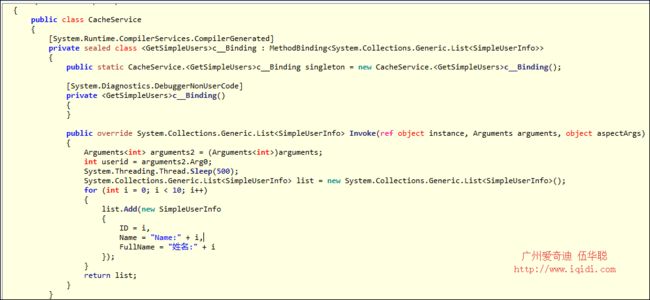在之前一篇随笔《在.NET项目中使用PostSharp,实现AOP面向切面编程处理》介绍了PostSharp框架的使用,试用PostSharp能给我带来很多便利和优势,减少代码冗余,提高可读性,并且可以更加优雅的实现常规的日志、异常、缓存、事务等业务场景的处理。本篇主要介绍使用MemoryCache实现缓存的处理。
1、MemoryCache的介绍回顾
上篇没有提及缓存的处理,一般情况下,缓存的处理我们可以利用微软的分布式缓存组件MemoryCache进行缓存的处理操作。MemoryCache的使用网上介绍的不多,不过这个是.NET4.0新引入的缓存对象,主要是替换原来企业库的缓存模块,使得.NET的缓存可以无处不在,而不用基于特定的Windows版本上使用。
缓存在很多情况下需要用到,合理利用缓存可以一方面可以提高程序的响应速度,同时可以减少对特定资源访问的压力。本文主要针对自己在Winform方面的缓存使用做一个引导性的介绍,希望大家能够从中了解一些缓存的使用场景和使用方法。缓存是一个中大型系统所必须考虑的问题。为了避免每次请求都去访问后台的资源(例如数据库),我们一般会考虑将一些更新不是很频繁的,可以重用的数据,通过一定的方式临时地保存起来,后续的请求根据情况可以直接访问这些保存起来的数据。这种机制就是所谓的缓存机制。
.NET 4.0的缓存功能主要由三部分组成:System.Runtime.Caching,System.Web.Caching.Cache和Output Cache。
System.Runtime.Caching这是在.NET 4.0中新增的缓存框架,主要是使用MemoryCache对象,该对象存在于程序集System.Runtime.Caching.dll。
System.Web.Caching.Cache这个则是在.NET2.0开始就一直存在的缓存对象,一般主要用在Web中,当然也可以用于Winform里面,不过要引用System.Web.dll。
Output Cache则是Asp.NET里面使用的,在ASP.NET 4.0之前的版本都是直接使用System.Web.Caching.Cache来缓存HTML片段。在ASP.NET 4.0中对它进行了重新设计,提供了一个OutputCacheProvider供开发人员进行扩展,但是它默认情况下,仍然使用System.Web.Caching.Cache来做做缓存
我在之前的一篇随笔《Winform里面的缓存使用》曾经介绍了MemoryCache辅助类的处理,用来方便实现缓存的数据操作。它的辅助类主要代码如下所示。
///
/// 基于MemoryCache的缓存辅助类
///
public static class MemoryCacheHelper
{
private static readonly Object locker = new object();
///
/// 创建一个缓存的键值,并指定响应的时间范围,如果失效,则自动获取对应的值
///
/// 对象类型
/// 对象的键
/// 获取缓存值的操作
/// 失效的时间范围
/// 失效的绝对时间
/// (String key, Func cachePopulate, TimeSpan? slidingExpiration = null, DateTime? absoluteExpiration = null)
{
if(String.IsNullOrWhiteSpace(key)) throw new ArgumentException("Invalid cache key");
if(cachePopulate == null) throw new ArgumentNullException("cachePopulate");
if(slidingExpiration == null && absoluteExpiration == null) throw new ArgumentException("Either a sliding expiration or absolute must be provided");
if(MemoryCache.Default[key] == null)
{
lock(locker)
{
if(MemoryCache.Default[key] == null)
{
var item = new CacheItem(key, cachePopulate());
var policy = CreatePolicy(slidingExpiration, absoluteExpiration);
MemoryCache.Default.Add(item, policy);
}
}
}
return (T)MemoryCache.Default[key];
}
private static CacheItemPolicy CreatePolicy(TimeSpan? slidingExpiration, DateTime? absoluteExpiration)
{
var policy = new CacheItemPolicy();
if(absoluteExpiration.HasValue)
{
policy.AbsoluteExpiration = absoluteExpiration.Value;
}
else if(slidingExpiration.HasValue)
{
policy.SlidingExpiration = slidingExpiration.Value;
}
policy.Priority = CacheItemPriority.Default;
return policy;
}
///
/// 清空缓存
///
public static void ClearCache()
{
List cacheKeys = MemoryCache.Default.Select(kvp => kvp.Key).ToList();
foreach (string cacheKey in cacheKeys)
{
MemoryCache.Default.Remove(cacheKey);
}
}
...//省略部分代码
}
而我们在程序中,如果需要使用缓存,那么调用这个辅助类来解决,也算是比较方便的,实现缓存的代码如下所示。
public static class UserCacheService
{
///
/// 获取用户全部简单对象信息,并放到缓存里面
///
/// GetSimpleUsers()
{
System.Reflection.MethodBase method = System.Reflection.MethodBase.GetCurrentMethod();
string key = string.Format("{0}-{1}", method.DeclaringType.FullName, method.Name);
return MemoryCacheHelper.GetCacheItem>(key,
delegate() {
//return CallerFactory.Instance.GetSimpleUsers();
//模拟从数据库获取数据
List list = new List();
for(int i = 0; i< 10; i++)
{
var info = new SimpleUserInfo();
info.ID = i;
info.Name = string.Concat("Name:", i);
info.FullName = string.Concat("姓名:", i);
list.Add(info);
}
return list;
},
new TimeSpan(0, 10, 0));//10分钟过期
}
///
/// 根据用户的ID,获取用户的登陆名称,并放到缓存里面
///
/// 用户的ID
/// (key,
delegate() {
//return CallerFactory.Instance.GetNameByID(userId.ToInt32());
return string.Concat("Name:", userId);
},
new TimeSpan(0, 30, 0));//30分钟过期
}
return result;
}
上面案例我模拟构造数据库数据返回,否则一般使用BLLFactory
案例中可以设置失效缓存时间,并且失效后,自动通过Func
2、结合PostSharp和MemoryCache实现缓存
上面的案例使用MemoryCache辅助类来实现缓存的处理,能够解决实际的问题,不过同时问题也来了,每次缓存处理,都需要写一段额外的代码进行处理,代码的冗余就非常多了,而且一旦很多地方采用缓存,那么维护这些代码就很成问题。
我们希望引入PostSharp技术,来减少系统的重复代码,降低模块间的耦合度,并有利于未来的可操作性和可维护性。这种AOP的代码织入技术能够很好分离横切面和业务处理,从而实现简化代码的目的。
就上面的代码问题,我们来看看,引入PostSharp后,我们的代码是如何实现缓存处理的。
///
/// 使用PostSharp,结合MemoryCache实现缓存的处理类
///
public class CacheService
{
///
/// 获取用户全部简单对象信息,并放到缓存里面
///
/// GetSimpleUsers(int userid)
{//return CallerFactory.Instance.GetSimpleUsers();
//模拟从数据库获取数据
List list = new List();
for (int i = 0; i < 10; i++)
{
var info = new SimpleUserInfo();
info.ID = i;
info.Name = string.Concat("Name:", i);
info.FullName = string.Concat("姓名:", i);
list.Add(info);
}
return list;
}
///
/// 根据用户的ID,获取用户的登陆名称,并放到缓存里面
///
/// 用户的ID
/// .Instance.GetNameByID(userId.ToInt32());
return string.Concat("Name:", userId);
}
}
我们注意到了上面的函数代码,除了调用业务逻辑(这里构造数据演示)外,其实是没有多余的其他代码的。不过我们是在函数开始进行了一个特性的标识:
[Cache(ExpirationPeriod = 30)]
或者
[Cache]
这个就是我们声明使用缓存处理的函数,如此而已,是不是非常简单了。
我们来看看生成后的代码反编译得到的结果,如下所示。
这个和我们实际的代码是不太一样的,这里整合了PostSharp的织入代码,从而能够实现缓存的处理操作了,但是我们在开发过程中是透明的,只需要维护好自己编写的代码即可。
这个里面需要使用了CacheAttribute来进行标识,这个类的代码就是使用了PostSharp的基类进行处理了
///
/// 方法实现缓存的标识
///
[Serializable]
public class CacheAttribute : MethodInterceptionAspect
{
///
/// 缓存的失效时间设置,默认采用30分钟
///
public int ExpirationPeriod = 30;
///
/// PostSharp的调用处理,实现数据的缓存处理
///
public override void OnInvoke(MethodInterceptionArgs args)
{
//默认30分钟失效,如果设置过期时间,那么采用设置值
TimeSpan timeSpan = new TimeSpan(0, 0, ExpirationPeriod, 0);
var cache = MethodResultCache.GetCache(args.Method, timeSpan);
var arguments = args.Arguments.ToList();
var result = cache.GetCachedResult(arguments);
if (result != null)
{
args.ReturnValue = result;
return;
}
else
{
base.OnInvoke(args);
//调用后重新更新缓存
cache.CacheCallResult(args.ReturnValue, arguments);
}
}
}
这个CacheAttribute特性类包含一个设置失效的时间间隔(分钟),来指定函数返回结果的失效时间的,通过继承MethodInterceptionAspect基类,我们重写了void OnInvoke(MethodInterceptionArgs args)函数,从而对调用过程的横切面进行介入:
如果调用过程中获得缓存结果,则直接返回,不需要调用函数业务逻辑;否则调用函数获得返回值,并重新设置缓存结果值。
在函数代码里面,通过传入参数(包括方法对象、超时时间等)实现方法缓存对象的构建。
MethodResultCache.GetCache(args.Method, timeSpan);
在MethodResultCache里面,我们就是对方法的缓存进行处理的,首先需要声明一个MemoryCache的对象用于管理缓存(分布式缓存)。
///
/// 初始化缓存管理器
///
private void InitCacheManager()
{
_cache = new MemoryCache(_methodName);
}
其中通过函数获取方法和参数的键,也就是唯一的键。
///
/// 根据调用方法名称和参数获取缓存键
///
/// 方法的参数列表
/// 设置缓存的操作,我们就是调用MemoryCache缓存管理类来实现的键值设置的,如下代码所示。
///
/// 缓存结果内容
///
/// 待加入缓存的结果
/// 方法的参数集合
public void CacheCallResult(object result, IEnumerable这样我们就设置了一个键值的缓存,并指定了缓存的失效时间,在这个时间段内,我们每次获取的数据,不需要再次调用外部接口,直接从缓存里面获取,速度提高很多,同时也减轻了分布式构架中的服务器承载的IO压力。
我们可以编写一小段代码进行测试出来的效率,如下代码所示。
//First test
DateTime start = DateTime.Now;
var list = CacheService.GetSimpleUsers(1);
int end = (int)DateTime.Now.Subtract(start).TotalMilliseconds;
Console.WriteLine(" first: " + end);
//Second test
start = DateTime.Now;
list = CacheService.GetSimpleUsers(2);
end = (int)DateTime.Now.Subtract(start).TotalMilliseconds;
Console.WriteLine(" Second: " + end);
获得的结果如下所示(分别介绍获得结果的时间)。
first: 519
Second: 501
first: 0
Second: 0
first: 0
Second: 0
从上面代码可以看出,第一次请求数据的有一定的时间差,后面请求毫秒数则是直接0了。
通过上面的 PostSharp和MemoryCache的整合,我们可以极大简化了缓存的处理代码,并且能够利用较为不错的MemoryCache缓存管理类来实现缓存的处理,非常方便和高效了。
